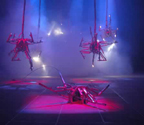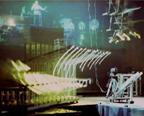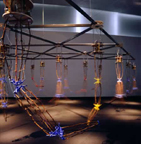August 25, 2006
Interactive Architecture dot Org X 4

Robotic Art
You Move Me (Work in Progress) by Lara Greene [cable tests movie 58MB - requires QuickTime] :: The figure is a fully articulated machine that moves via cables extending out from within the body to multifunctioning levers that can be pushed pulled and twisted to create various movements and affect it's position in space. A group of up to 6 people will be required to operate the piece, these being visiting members of the public. The figure has the capacity for elegance or awkwardness, dependent upon the level of people's control and ability or desire to co-operate with each other. People will struggle with or surmount this challenge, as she responds and embodies these conditions the character will come to life allowing people to empathise and respond in return. You move me is a tool for expression that draws people together in a web of interdependency provoking many forms of communication. [via Interactive Architecture dot Org]
Hysterical Machines - Bill Vorn

Bill Vorn is working in the field of Robotic Art since 1992. His installation projects involve robotics and motion control, sound, lighting, video and cybernetic processes. He pursues research on Artificial Life (and Death) and Agent Technologies through artistic work based on the Aesthetics of Artificial Behaviors.
Each Hysterical Machines has a spherical body and eight arms made of aluminum tubing. It has a sensing system, a motor system and a control system that functions as an autonomous nervous system (entirely reactive). Some machines are suspended from the ceiling and their arms are actuated by pneumatic valves and cylinders. Pyroelectric sensors allow the robots to detect the presence of viewers in the nearby environment. They react to the viewers according to the amount of stimuli they receive. The perceived emergent behaviors of these machines engender a multiplicity of interpretations based on single dynamic pattern of events.
The aim of this project is to induce empathy of the viewer towards characters which are nothing more than articulated metal structures. The strength of the simulacra is emphasized by perverting the perception of the creatures, which are neither animals nor humans, carried through the inevitable instinct of anthropomorphism and projection of our internal sensations, a reflex triggered by any phenomenon that challenges our senses.

The Mechanized Eccentric Performance Series
Louis-Philippe Demers is a multidisciplinary artist using machines as media. He has worked on the conception and production of several large-scale interactive robotic installations, so far realizing more than 225 machines. 'In a more pronounced way than traditional theatre, mechanical theatre becomes a space for a collective consensus of the acceptation of simulacrum (even more surreal). The level of abstraction of the mechanical theatre enables a multiplicity of interpretation, it is an open ended work where each person sees a reflection of its own feelings.' (See Video)
The Mechanized Eccentric Series is a collection of several installations and performances united together in a large spectacle.
The Series regroups:
L'Assemblee, 48 robots layed out on an arena;
Colony 001, 8 robots and 1 central robots, a comment on nanotechnology;
Colony 002, 8 robots caught in cages;
The robotic characters of Armageddon (an operetta for robots) and a choir of 12 members;
and the two main robots of Le Proces.
Each robot is equipped with speaker(s), light(s) and motion(s) enabling the whole environment to become a vast surround soundscape. Namely, the performances include 6 voices of ambient sound plus a range (8 to 32) of independent robot sounds.

I thought after a week mainly showing some robotics based projects, I'd post a little about one of my favourite pieces of work by one of my favourite artists, Ken Rinaldo. Video
Ken Rinaldo is an artist and theorist who creates interactive multimedia installations that blur the boundaries between the organic and inorganic. He has been working at the intersection of art and biology for over two decades working in the catagories of interactive robotics, biological art, artificial life, interspecies communication, rapid prototyping and digital imaging. Rinaldo teaches interactive robotic sculpture, digital imaging, multimedia and Directs the Art and Technology program in the Department of Art at The Ohio State University in Columbus Ohio.
It consists of fifteen robotic sound sculptures that interact with the public and modify their behaviors over time. These behaviors change based on feedback from infrared sensors, the presence of the participant/viewers in the exhibition and the communication between each separate sculpture. This series of robotic sculptures talk with each other through a computer network and audible telephone tones, which are a musical language for the group. Autopoiesis is "self making", a characteristic of all living systems which was defined and refined by Francisco Varella and Humberto Maturana. The interactivity engages the viewer/participant who in turn, effects the system's evolution and emergence. This creates a system evolution as well as an overall group sculptural aesthetic.
In Autopoiesis the robotic sensors compare their sensor data through a central-state controller, so the viewer is able to walk through the sculptural installation and have the arms interact both individually and as a group. Because each arm has its own on-board computer control, the overall speed of reaction is rapid and therefore, life-like. Local control always supercedes group control when a local sensor is aware of a human nearby. This also allows individual arms to show accuracy and delicacy of approach and avoidance when encountering the viewer/participant. At the tip of two of the arms, lipstick cameras project what they see onto the walls of the space. This gives the viewer/participant a sense of being observed by this artificial life robotic sculpture.
Also see Regine from wmmna's recent interview with Ken Rinaldo.
Posted by jo at August 25, 2006 09:00 AM
